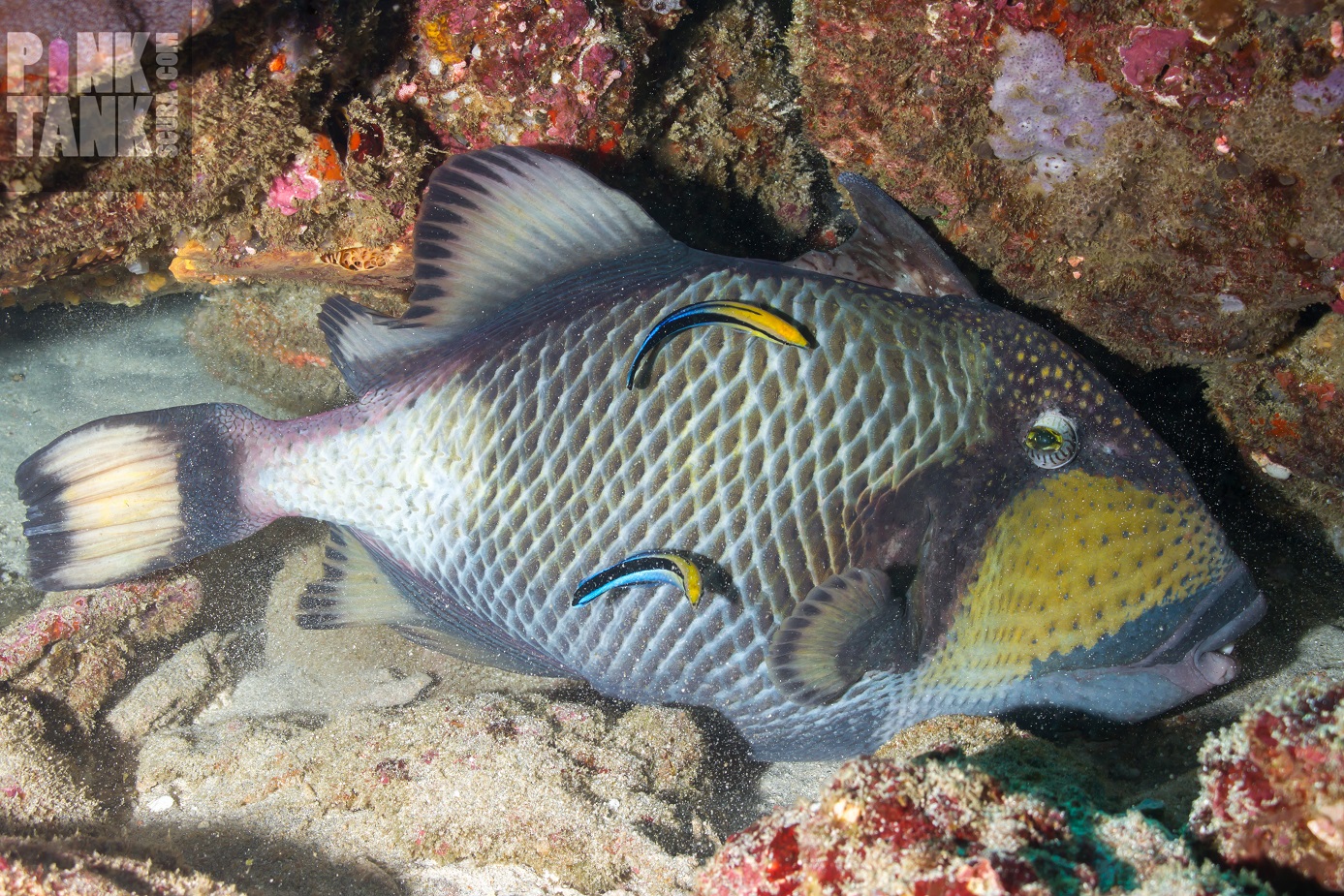I recently came across this photo of a sunfish (Mola) at Nusa Lambongan, apparently being cleaned by bannerfish (Heniochus) posted by PT Hirschfield of Pink Tank Scuba on her Facebook page.
Heniochus banner fish cleaning a sunfish
(Image supplied PT Hirschfield / Pink Tank Scuba)
The apparent cleaning of the sunfish by the bannerfish caught my eye. The situation is yet another case of fish cleaning.
There was a suggestion on the Facebook post that the bannerfish are Moorish Idols. I had to point out that they are Heniochus, not Moorish Idols. Heniochus are ‘poor man’s Moorish Idols’ – See http://www.saltwatersmarts.com/poor-mans-moorish-idol-schooling-bannerfish-heniochus-diphreutes-3152/ where it states, “the schooling bannerfish (Heniochus diphreutes) from the Indo-Pacific, which bears a striking resemblance to the …..Moorish idol (Zanclus cornutus”.
I asked PT about the fish cleaning. She confirmed that the bannerfish were indeed cleaning the sunfish. She also mentioned that Emperor Angelfish did the same, and she posted this other photo on her Facebook page:-
Emperor Angelfish & Heniochus banner fish cleaning a sunfish
(Image supplied PT Hirschfield / Pink Tank Scuba)
Here is a cropped image of the Emperor Angelfish cleaning the sunfish: –
Cropped image of an Emperor Angelfish cleaning a sunfish (Mola) at Lambongan
(Image supplied PT Hirschfield / Pink Tank Scuba)
Certainly, the cropped image is unclear, but the situation is very clear.
An online search for details regarding sunfish cleaning by both Emperor Angelfish and Heniochus banner fish revealed the following: –
A paper titled “Adult emperor angelfish (Pomacanthus imperator) clean giant sunfishes (Mola mola) at Nusa Lambongan, Indonesia” by Konow, N., Fitzpatrick, R., and Barnet, A. (2006) can be found at https://researchonline.jcu.edu.au/34301/ .
According to the extract for the paper, “Over 4 days in October 2004, up to 16 ectoparasite-laden Giant Sunfishes (Mola Mola) were observed off Nusa Lembongan, Indonesia, confirming indigenous reports of annual Mola aggregations at a short stretch of coral reef slope. An ‘assembly line’ of five coral reef species cleaning separate Mola body regions was documented. Butterflyfish species (Chaetodon kleinii and Heniochus diphreutes) cleaned the ventral and head areas respectively, while wrasses (Labroides dimidiatus and Thalasoma lunare) covered flank regions. Surprisingly, of 37 observed cleaning events, ~40% were dominated by large Emperor angelfishes, Pomacanthus imperator (n≤12;total length<55cm).”
Five fish cleaning species were listed, including both Emperor Angelfish, Pomacanthus imperator and Heniochus bannerfish, Heniochus diphreutes. I have already discussed both the wrasses Labroides dimidiatus and Thalasoma lunare in my earlier articles, but not Emperor angelfishes, Pomacanthus imperator, Heniochus bannerfish, Heniochus diphreutes or Klein’s butterflyfish Chaetodon kleinii.
According to “Hawaii’s Fishes – A Guide for Snorkelers and Divers” by John P Hoover, Heniochus diphreutes, are also known as Pennant Butterfly fish, Longfin Bannerfish and Pennantfish.
Further details regarding Mola sunfish can be found at https://www.starfish.ch/collection/sunfish.html .
PT also offered to send me this image of a Titan Triggerfish, Balistoides viridescens in a cleaning station in Bali: –
Titan Triggerfish in Cleaning Station Bali
(Image supplied PT Hirschfield / Pink Tank Scuba)
The two cleaner fish on the Titan Triggerfish appear to be Bluestreak Cleaner Wrasse, Labroides dimidiatus.
“World Atlas of Marine Fishes” by Rudie H Kuiter & Helmut Debelius features a photo of several Gobiosoma genie cleaning a large fish. There are several other species of Gobiosoma in the book, including Gobiosoma oceanops. Gobiosoma oceanops seems to be the Neon Goby, also called neon cleaner goby (Elacatinus oceanops).
According to Wikipedia, “Elacatinus is a genus of small marine gobies, often known collectively as the neon gobies. Although only one species, E. oceanops, is technically the “neon goby,” because of their similar appearance, other members of the genus are generally labeled neon gobies, as well. Except for a single East Pacific species, all reside in warmer parts of the West Atlantic, including the Caribbean and Gulf of Mexico. They are known for engaging in symbiosis with other marine creatures by providing them cleaning service that consists of getting rid of ectoparasites on their bodies. In return, Elacatinus species obtain their primary source of food, ectoparasites.”
My thanks got to PT Hirschfield of Pink Tank Scuba for her kind assistance in this topic, especially her permission for the use of her photos.






[…] of PT Hirschfield’s sunfish photos can be seen featured in my article titled More Tropical Fish Cleaners. All of these photos were at taken at Nusa Lambongan and showing a sunfish apparently being cleaned […]
[…] of PT Hirschfield’s sunfish photos can be seen featured in my article titled More Tropical Fish Cleaners. All of these photos were at taken at Nusa Lambongan and showing a sunfish apparently being cleaned […]